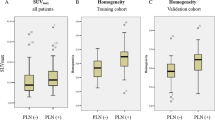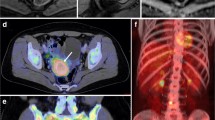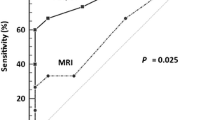Abstract
Purpose
To evaluate the correlation of radiomic features in pelvic [2-deoxy-2-18F]fluoro-d-glucose positron emission tomography/magnetic resonance imaging and computed tomography ([18F]FDG PET/MRI and [18F]FDG PET/CT) in patients with primary cervical cancer (CCa).
Procedures
Nineteen patients with histologically confirmed primary squamous cell carcinoma of the cervix underwent same-day [18F]FDG PET/MRI and PET/CT. Two nuclear medicine physicians performed a consensus reading in random order. Free-hand regions of interest covering the primary cervical tumors were drawn on PET, contrast-enhanced pelvic CT, and pelvic MR (T2 weighted and ADC) images. Several basic imaging features, standard uptake values (SUVmean, SUVmax, and SUVpeak), total lesion glycolysis (TLG), metabolic tumor volume (MTV), and more advanced texture analysis features were calculated. Pearson’s correlation test was used to assess the correlation between each pair of features. Features were compared between local and metastatic tumors, and their role in predicting metastasis was evaluated by receiver operating characteristic curves.
Results
For a total of 101 extracted features, 1104/5050 pairs of features showed a significant correlation (ρ ≥ 0.70, p < 0.05). There was a strong correlation between 190/484 PET pairs of features from PET/MRI and PET/CT, 91/418 pairs of CT and PET from PET/CT, 79/418 pairs of T2 and PET from PET/MRI, and 50/418 pairs of ADC and PET from PET/MRI. Significant difference was seen between eight features in local and metastatic tumors including MTV, TLG, and entropy on PET from PET/CT; MTV and TLG on PET from PET/MRI; compactness and entropy on T2; and entropy on ADC images.
Conclusions
We demonstrated strong correlation of many extracted radiomic features between PET/MRI and PET/CT. Eight radiomic features calculated on PET/CT and PET/MRI were significantly different between local and metastatic CCa. This study paves the way for future studies to evaluate the diagnostic and predictive potential of radiomics that could guide clinicians toward personalized patients care.



Similar content being viewed by others
Change history
14 November 2021
Due to a production error, this article was updated to include the statement “Shadi A. Esfahani and Angel Torrado-Carvajal contributed equally to this manuscript.”
22 November 2021
A Correction to this paper has been published: https://doi.org/10.1007/s11307-021-01671-4
References
Bray F, Ferlay J, Soerjomataram I, Siegel RL, Torre LA, Jemal A (2018) Global cancer statistics 2018: GLOBOCAN estimates of incidence and mortality worldwide for 36 cancers in 185 countries. CA Cancer J Clin 68:394–424
Papadia A, Gasparri ML, Genoud S, Bernd K, Mueller MD (2017) The combination of preoperative PET/CT and sentinel lymph node biopsy in the surgical management of early-stage cervical cancer. J Cancer Res Clin Oncol 143:2275–2281
Yang Z, Xu W, Ma Y, Liu K, Li Y, Wang D (2016) (18)F-FDG PET/CT can correct the clinical stages and predict pathological parameters before operation in cervical cancer. Eur J Radiol 85:877–884
Li K, Sun H, Lu Z et al (2018) Value of [(18)F]FDG PET radiomic features and VEGF expression in predicting pelvic lymphatic metastasis and their potential relationship in early-stage cervical squamous cell carcinoma. Eur J Radiol 106:160–166
Nogami Y, Iida M, Banno K et al (2014) Application of FDG-PET in cervical cancer and endometrial cancer: utility and future prospects. Anticancer Res 34:585–592
Zhou Z, Liu X, Hu K, Zhang F (2018) The clinical value of PET and PET/CT in the diagnosis and management of suspected cervical cancer recurrence. Nucl Med Commun 39:97–102
Schick U, Lucia F, Dissaux G et al (2019) MRI-derived radiomics: methodology and clinical applications in the field of pelvic oncology. Br J Radiol 92:20190105
Floberg JM, Fowler KJ, Fuser D et al (2018) Spatial relationship of 2-deoxy-2-[(18)F]-fluoro-D-glucose positron emission tomography and magnetic resonance diffusion imaging metrics in cervical cancer. EJNMMI Res 8:52
Amorim BJ, Torrado-Carvajal A, Esfahani SA et al (2020) PET/MRI radiomics in rectal cancer: a pilot study on the correlation between PET- and MRI-derived image features with a clinical interpretation. Mol Imaging Biol 22:1438–1445
Brendle CB, Schmidt H, Fleischer S, Braeuning UH, Pfannenberg CA, Schwenzer NF (2013) Simultaneously acquired MR/PET images compared with sequential MR/PET and PET/CT: alignment quality. Radiology 268:190–199
Atkinson W, Catana C, Abramson JS et al (2016) Hybrid FDG-PET/MR compared to FDG-PET/CT in adult lymphoma patients. Abdom Radiol (NY) 41:1338–1348
Lambin P, Rios-Velazquez E, Leijenaar R et al (2012) Radiomics: extracting more information from medical images using advanced feature analysis. Eur J Cancer 48:441–446
Gillies RJ, Kinahan PE, Hricak H (2016) Radiomics: images are more than pictures, they are data. Radiology 278:563–577
Lucia F, Visvikis D, Desseroit MC et al (2018) Prediction of outcome using pretreatment (18)F-FDG PET/CT and MRI radiomics in locally advanced cervical cancer treated with chemoradiotherapy. Eur J Nucl Med Mol Imaging 45:768–786
Catalano OA, Horn GL, Signore A et al (2017) PET/MR in invasive ductal breast cancer: correlation between imaging markers and histological phenotype. Br J Cancer 116:893–902
Lucia F, Visvikis D, Vallieres M et al (2019) External validation of a combined PET and MRI radiomics model for prediction of recurrence in cervical cancer patients treated with chemoradiotherapy. Eur J Nucl Med Mol Imaging 46:864–877
Amorim BJ, Hong TS, Blaszkowsky LS et al (2019) Clinical impact of PET/MR in treated colorectal cancer patients. Eur J Nucl Med Mol Imaging 46:2260–2269
Catalano OA, Lee SI, Parente C, et al. (2021) Improving staging of rectal cancer in the pelvis: the role of PET/MRI. Eur J Nucl Med Mol Imaging 48:1235-1245. https://doi.org/10.1007/s00259-020-05036-x
Esfahani SA, Heidari P, Halpern EF, Hochberg EP, Palmer EL, Mahmood U (2013) Baseline total lesion glycolysis measured with (18)F-FDG PET/CT as a predictor of progression-free survival in diffuse large B-cell lymphoma: a pilot study. Am J Nucl Med Mol Imaging 3:272–281
Bhatla N, Berek JS, Cuello Fredes M et al (2019) Revised FIGO staging for carcinoma of the cervix uteri. Int J Gynaecol Obstet 145:129–135
Koh WJ, Abu-Rustum NR, Bean S et al (2019) Cervical cancer, version 3.2019, NCCN Clinical Practice Guidelines in Oncology. J Natl Compr Canc Netw 17:64–84
Brandmaier P, Purz S, Bremicker K et al (2015) Simultaneous [18F]FDG-PET/MRI: correlation of apparent diffusion coefficient (ADC) and standardized uptake value (SUV) in primary and recurrent cervical cancer. PLoS One 10:e0141684
Grueneisen J, Beiderwellen K, Heusch P et al (2014) Correlation of standardized uptake value and apparent diffusion coefficient in integrated whole-body PET/MRI of primary and recurrent cervical cancer. PLoS One 9:e96751
Catalano OA, Daye D, Signore A et al (2017) Staging performance of whole-body DWI, PET/CT and PET/MRI in invasive ductal carcinoma of the breast. Int J Oncol 51:281–288
Pace L, Nicolai E, Aiello M, Catalano OA, Salvatore M (2013) Whole-body PET/MRI in oncology: current status and clinical applications. Clin Transl Imaging 1:31–44
Beiderwellen K, Gomez B, Buchbender C et al (2013) Depiction and characterization of liver lesions in whole body [(1)(8)F]-FDG PET/MRI. Eur J Radiol 82:e669-675
Rakheja R, Chandarana H, DeMello L et al (2013) Correlation between standardized uptake value and apparent diffusion coefficient of neoplastic lesions evaluated with whole-body simultaneous hybrid PET/MRI. AJR Am J Roentgenol 201:1115–1119
Catalano OA, Coutinho AM, Sahani DV et al (2017) Colorectal cancer staging: comparison of whole-body PET/CT and PET/MR. Abdom Radiol (NY) 42:1141–1151
Ho KC, Lin G, Wang JJ, Lai CH, Chang CJ, Yen TC (2009) Correlation of apparent diffusion coefficients measured by 3T diffusion-weighted MRI and SUV from FDG PET/CT in primary cervical cancer. Eur J Nucl Med Mol Imaging 36:200–208
Chung HH, Kang SY, Ha S et al (2016) Prognostic value of preoperative intratumoral FDG uptake heterogeneity in early stage uterine cervical cancer. J Gynecol Oncol 27:e15
Reuze S, Orlhac F, Chargari C et al (2017) Prediction of cervical cancer recurrence using textural features extracted from 18F-FDG PET images acquired with different scanners. Oncotarget 8:43169–43179
Cima S, Perrone AM, Castellucci P et al (2018) Prognostic impact of pretreatment fluorodeoxyglucose positron emission tomography/computed tomography SUVmax in patients with locally advanced cervical cancer. Int J Gynecol Cancer 28:575–580
Yagi S, Yahata T, Mabuchi Y et al (2016) Primary tumor SUVmax on preoperative FDG-PET/CT is a prognostic indicator in stage IA2–IIB cervical cancer patients treated with radical hysterectomy. Mol Clin Oncol 5:216–222
Xue F, Lin LL, Dehdashti F, Miller TR, Siegel BA, Grigsby PW (2006) F-18 fluorodeoxyglucose uptake in primary cervical cancer as an indicator of prognosis after radiation therapy. Gynecol Oncol 101:147–151
Antonsen SL, Loft A, Fisker R et al (2013) SUVmax of 18FDG PET/CT as a predictor of high-risk endometrial cancer patients. Gynecol Oncol 129:298–303
van Rossum PSN, Xu C, Fried DV, Goense L, Court LE, Lin SH (2016) The emerging field of radiomics in esophageal cancer: current evidence and future potential. Transl Cancer Res 5:410–423
Chen X, Liu W, Thai TC et al (2020) Developing a new radiomics-based CT image marker to detect lymph node metastasis among cervical cancer patients. Comput Methods Programs Biomed 197:105759
Lohmann P, Kocher M, Ruge MI et al (2020) PET/MRI radiomics in patients with brain metastases. Front Neurol 11:1
Weber M, Kessler L, Schaarschmidt B et al (2020) Treatment-related changes in neuroendocrine tumors as assessed by textural features derived from (68)Ga-DOTATOC PET/MRI with simultaneous acquisition of apparent diffusion coefficient. BMC Cancer 20:326
Shaikh F, Dupont-Roettger D, Dehmeshki J, Kubassova O, Quraishi MI (2020) Advanced imaging of biochemical recurrent prostate cancer with PET, MRI, and radiomics. Front Oncol 10:1359
Lai AYT, Perucho JAU, Xu X, Hui ES, Lee EYP (2017) Concordance of FDG PET/CT metabolic tumour volume versus DW-MRI functional tumour volume with T2-weighted anatomical tumour volume in cervical cancer. BMC Cancer 17:825
Wu Q, Shi D, Dou S et al (2019) Radiomics analysis of multiparametric MRI evaluates the pathological features of cervical squamous cell carcinoma. J Magn Reson Imaging 49:1141–1148
Ai Y, Zhu H, Xie C, Jin X (2020) Radiomics in cervical cancer: current applications and future potential. Crit Rev Oncol Hematol 152:102985
Meyer HJ, Purz S, Sabri O, Surov A (2018) Cervical cancer: associations between metabolic parameters and whole lesion histogram analysis derived from simultaneous (18)F-FDG-PET/MRI. Contrast Media Mol Imaging 2018:5063285
Sun H, Xin J, Zhang S et al (2014) Anatomical and functional volume concordance between FDG PET, and T2 and diffusion-weighted MRI for cervical cancer: a hybrid PET/MR study. Eur J Nucl Med Mol Imaging 41:898–905
Pinker K, Andrzejewski P, Baltzer P et al (2016) Multiparametric [18F]fluorodeoxyglucose/[18F]fluoromisonidazole positron emission tomography/magnetic resonance imaging of locally advanced cervical cancer for the non-invasive detection of tumor heterogeneity: a pilot study. PLoS One 11:e0155333
Surov A, Meyer HJ, Schob S et al (2017) Parameters of simultaneous 18F-FDG-PET/MRI predict tumor stage and several histopathological features in uterine cervical cancer. Oncotarget 8:28285–28296
Martinez-Moller A, Souvatzoglou M, Delso G et al (2009) Tissue classification as a potential approach for attenuation correction in whole-body PET/MRI: evaluation with PET/CT data. J Nucl Med 50:520–526
Rao RK, Riffel P, Meyer M et al (2012) Implementation of dual-source RF excitation in 3 T MR-scanners allows for nearly identical ADC values compared to 1.5 T MR scanners in the abdomen. PLoS One 7:e32613
Zhao Q, Feng Y, Mao X, Qie M (2013) Prognostic value of fluorine-18-fluorodeoxyglucose positron emission tomography or PET-computed tomography in cervical cancer: a meta-analysis. Int J Gynecol Cancer 23:1184–1190
Kidd EA, El Naqa I, Siegel BA, Dehdashti F, Grigsby PW (2012) FDG-PET-based prognostic nomograms for locally advanced cervical cancer. Gynecol Oncol 127:136–140
Author information
Authors and Affiliations
Contributions
S.A.E., A.T.C., D.G., L.D., H.B., D.S., D.G., B.J.A., and O.A.C. contributed to the concept and design of the study. D.G., L.D., H.B., D.S., and O.A.C. contributed to the acquisition of the data. S.A.E., A.T.C., D.G., H.B., L.D., B.J.A., D.S., D.G., and O.A.C. contributed to the analysis and interpretation of the data. S.A.E., A.T.C., and O.A.C. drafted the manuscript. All authors read, critically revised, and approved the manuscript. All the authors agree to be accountable for all aspects of the work in ensuring that questions related to the accuracy or integrity of any part of the work are appropriately investigated and resolved.
Corresponding author
Ethics declarations
Ethics Approval
The study has been approved by the institutional research ethics committee and have been performed in accordance with the ethical standards as laid down in the 1964 Declaration of Helsinki and its later amendments or comparable ethical standards.
Given its retrospective nature, the institutional ethical committee waived the need of written informed consent.
Conflict of Interest
A.T.C. was partially supported by the Young Researchers R&D Project M2166 (MIMC3-PET/MR) financed by Community of Madrid and Rey Juan Carlos University. Other authors declare that they have no relevant disclosures.
Additional information
Publisher's Note
Springer Nature remains neutral with regard to jurisdictional claims in published maps and institutional affiliations.
Supplementary Information
Below is the link to the electronic supplementary material.
Rights and permissions
About this article
Cite this article
Esfahani, S.A., Torrado-Carvajal, A., Amorim, B.J. et al. PET/MRI and PET/CT Radiomics in Primary Cervical Cancer: A Pilot Study on the Correlation of Pelvic PET, MRI, and CT Derived Image Features. Mol Imaging Biol 24, 60–69 (2022). https://doi.org/10.1007/s11307-021-01658-1
Received:
Revised:
Accepted:
Published:
Issue Date:
DOI: https://doi.org/10.1007/s11307-021-01658-1




